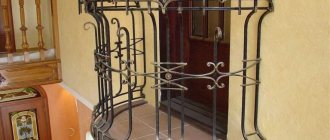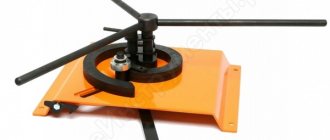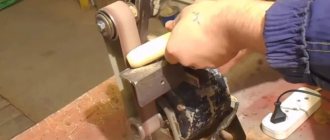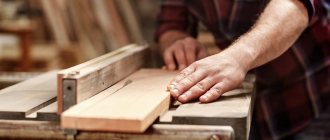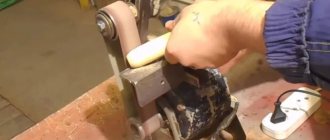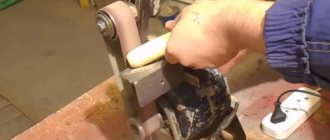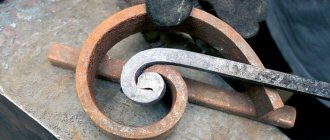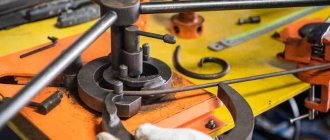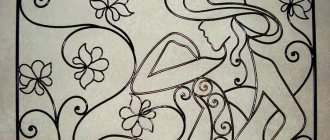One way to decorate areas is to use forged items. Fences, benches, gazebos, stair railings and other similar structures look very decorative. Moreover, in most cases, these products are not forging in its traditional sense. Most often, this is done not in a forge or with a hammer and anvil, but with the help of some devices that allow you to create a wide variety of patterns and products from metal strips and square rods. To make such products you will need cold forging machines. Some of them you can make with your own hands, others are easier to buy.
Fences, railings for stairs and balconies - you can also do it yourself
Canopy over the porch using cold forging
Porch railings are a decoration, not a purely utilitarian fixture.
You can make a gazebo and forged furniture
The gate looks magical
The beginning of cold forging with homemade machines.
Cold forging with your own hands requires two mandatory actions - pressing and bending. To perform all these actions, it is not necessary to apply a certain temperature to the metal, but it is still necessary to carry out heat treatment.
To design something with your own hands, it is no longer necessary to have special machines for artistic forging; now you can create machines for forging metal at home. But you still can’t cope with such tools without experience. For all the work to be successful, you need to use metals of a certain thickness.
A homemade cold forging machine can easily be used to create structures that will be much stronger than those made by stamping. Do-it-yourself forged products will turn out to be of high quality when everything is done correctly and without errors, because it is very difficult to correct them. After a few jobs, with the experience gained, you can begin to make excellent designs using homemade cold forging machines and fixtures.
When manufacturing a large number of identical metal structures, it is best to use drawings prepared in advance. Drawings for do-it-yourself cold forging machines are prepared in advance. In some cases, it will be better to warm up the part in order to get rid of defects in the future. Those who have recently started using homemade machines for cold forging should first think through a work plan, as well as acquire the necessary skills. The help of various video lessons on the Internet, as well as special courses, will not be superfluous here.
Homemade machine for cold forging.
What kind of devices are used?
Cold forging is characterized by various curls, bends, twisted rods, etc. Almost every type is made on a separate device - a specific machine. They can be driven manually or electrically. For small volumes “for yourself”, manual cold forging machines are used. Although they are not particularly productive, they are much easier to manufacture. If it is necessary to put production on stream, similar devices are made, but with electric motors. In this case, there is almost no need to physically work, but the complexity of making the device increases significantly. In our material we will talk about manual machines for cold forging.
What devices are used:
- Torsion bars. With their help, tetrahedral rods or strips of metal are twisted in the longitudinal direction. The result is twisted columns, which are also called torsion bars.
This is what a torsion bar and the machine of the same name look like - Flashlight. On this device, the rod is also twisted in the longitudinal direction, but it is also additionally bent in the transverse direction. It turns out something similar to a flashlight. Hence the name of the device.
This is how they make a flashlight - Twisters or snails. Form flat curls of different diameters.
Device for cold forging snail - for forming curls - Bending machines or benders. Allows you to bend rods or reinforcement at the required angle anywhere. For bending anywhere and at any angle - bending machines (bending machines)
- Wave. In fact, this is also a bend, but of a more complex design - it allows you to change the direction of bending, obtaining wavy parts.
Machine "Volna" - for the formation of the appropriate relief - Devices for processing the ends of parts - inertial stamping machines or other home-made devices.
Machines for shaping the ends of rods. In this case - crow's foot
For a beginning craftsman, the most relevant machine for cold forging is a snail. Only with its help you can make many interesting things - from a fence and gate to a bench and other similar products. In second place in terms of necessity is a torsion bar machine. It adds variety to the details. All the rest can be purchased or made as you improve and gain skill.
Machine components and necessary tools.
A do-it-yourself forging machine consists of certain devices. Among which must be:
- gnutik;
- snail;
- wave;
- globe;
- twister;
- flashlight;
These devices are best to use. You will need a do-it-yourself cold forging snail to weave steel rods. You can look at the photo to better see the design and an example of parts. Forging equipment for cold forging of metal plays an important role in the work. The main tool during the work will be a bender. This is a very simple element.
We make a machine.
To process pipes with hexagonal and round cross-sections, a “wave” is used. A “flashlight” is used to bend metal rods, and a twister is somewhat similar to it, a very convenient device. A globe is made into a large arc of profile rods.
Cold forging machines are most profitable to do yourself, because not everything can be processed with hand tools, and the price for an artistic forging machine is very high. When a master, using his skills and equipment, creates a design, it will be unique and special, even if in some ways it will not be as high quality as the factory one. When manufacturing a large number of parts, it would be correct to create a coductor on an electric motor. This makes the work process easier. A do-it-yourself cold forging machine must be suitable for types of work such as bending, twisting and drawing.
During the drawing process, the structure takes on a certain shape. Therefore, it must pass through the press, after which the cross-section of the primary material will become smaller. By flexible we mean creating a bend at the desired angle. For this you will need templates. Photos of drawings of forged products with your own hands are prepared in advance from which the template will be made. The curl is attached to the steel plate, and the sheet itself is secured in the machine holder. A slot is placed at the end of the workpiece, and the other end is secured in place. Using a lever, the end of the structure is influenced, which must be carried out along each bend of the plate, which is used as a template.
Products produced by cold forging
We invite you to familiarize yourself with the options for products that you can make using the cold forging method:
- The fence element is completely made using the cold forging method. Clamps are used to connect the parts. The following machines were used for manufacturing: “snail”, torsion bar, “bend” and “flashlight”.
- Soda bench - made by cold forging and covered with wood. Welding and clamps are used to connect the elements. Machines used in production were “snail”, torsion bar, and press.
- Balcony railings - production method - cold forging. The railing elements are connected using welding and clamps. The machines used in production are “wave”, “snail”, press.
- Stair railings are produced using the cold artistic forging method. The parts are connected by welding. The machines used in production are torsion bar, flashlight, and snail.
- Visor - the frame of the visor is made using cold forging. The parts are connected by welding. In the manufacturing process, machines were used - “snail”, “wave”, press.
- The grill is a simple design made using the cold forging method. Clamps and welding are used to connect the parts. The barbecue elements were produced on machines - torsion bar, "snail".
- Double bed - cold forging method is used for the backrests. Connections are made by welding and clamps. In the manufacturing process, machines were used - “snail”, “wave” and press.
As can be seen from all of the above, the cold forging method does not require large financial costs and is quite easy to learn, so if you decide to start learning blacksmithing with this method, then you did the right thing.
DIY cold forging machines.
Many experienced manufacturers assemble simple mechanisms with their own hands, which allow them to create unique designs. This is influenced by work experience. Drawings for do-it-yourself cold forging machines can be found in sufficient quantities on the Internet, as well as photos of cold forging products that can be obtained in the end. A photograph of such equipment allows the master to complete the drawing from scratch, if he has experience.
You can consider the “Snail” machine. Using it you can create various spirals or waves. To create such a machine, you need to have drawings for a do-it-yourself cold forging machine of this type, and also do everything in accordance with the technology. The working surface must consist of sheet metal. 4 mm thickness will be enough. Dimensions are set based on the size of the part. To give the shape, sheet metal 3 mm thick and in the form of strips is required. It is bent according to the template with pliers and a spiral is obtained.
To create a normal work process, you need to firmly fix one of the ends of the part. A rod equal to the width of the strips will help with this. To secure the work platform you will need to use a workbench. The main goal of everything is to give maximum immobility to the part, because during cold forging you need to put in a lot of effort.
Before starting the manufacture of any cold forging machine, using hand-made tools, you need templates, sketches and various drawings, including a drawing for do-it-yourself cold forging equipment.
You can make your markings more accurate by using graph paper. You need to draw a spiral on it, where the turns in the radius will increase. Equal distance must be properly maintained between them. This condition will be mandatory only for creating symmetrical patterns.
Cold forging machine.
Assembling the device
This version of the machine is used as an example because of its simplicity. Knowing the basic principles and sequence of equipment design, you can upgrade it at will. To assemble all parts of the equipment into a single whole, you will need to use:
- drill with carbide type drills;
- welding machine;
- a saw cutting metal or a hacksaw;
- metal sheet of the selected size;
- round metal pipe;
- metal rod;
- bearings of different sizes;
- bolts size M8.
To assemble a cold forging machine with your own hands, you need to use a proven sequence of actions:
- Initially, you need to assemble a stand that will serve as a support. To do this, all its components (pipe sections of the same size and the joints between them at the top and bottom edges) must be connected into a single whole. The design may resemble a stool in appearance. The connection is made using a welding machine, and the sections are cut with a saw.
- The next step is cutting the metal sheets. You should get circles of equal diameters and four triangles with equal sides. Triangular-shaped elements must be welded to the bottom of the connected pipe structure in such a way that something similar to a pyramid is formed. The base, which has a wider area, must be welded at the central point of the cut circle.
- Four strips that are located horizontally must be attached to a circle with an already welded element. This should be done using bolts; for this you will need a drill to make the holes.
- The next step is the construction of the handle. To do this you need to use two rods of different lengths. Their sizes can be determined by correlating them with the diameter of the circle. One rod should be commensurate with the diameter, the other should slightly exceed its size. When bending the first rod, you should maintain an angle of 30 degrees. Then weld both rods to each other, and then weld another rod into the lower part. There should also be a jumper between the first two sections, to which a lever is attached by welding, which should maintain the direction towards the structure made of rods.
A bearing for future directional variability in the device must be attached to the end of the attached lever, as well as to the segment located at the bottom of the structure. The upper section serves as a mount for a metal coil, which must be installed horizontally - it makes it possible to bend the metal. On the lower side of the segment, where there is a free end, a hole should be made equal in diameter to the size of the pipe section.
Read also: The diode on the switch does not light up
- The last step in the algorithm of actions when constructing a machine for cold forging with your own hands will be the connection of the designed handle with a part of the device similar to a “pyramid”. These elements are fixed after putting on the handle with a wide-diameter nut, to which it is first necessary to weld a metal circle, which will allow the template itself to be attached to the machine. Next, the “snail” template is attached by welding.
Anyone who decides to take up forging seriously and make a cold forging machine with their own hands should be very scrupulous at the stage of creating drawings and calculations. Otherwise, the creation process is quite simple, and once you understand the principle of equipment design, you can come up with various variations of it that will help improve the product.
One way to decorate areas is to use forged items. Fences, benches, gazebos, stair railings and other similar structures look very decorative. Moreover, in most cases, these products are not forging in its traditional sense. Most often, this is done not in a forge or with a hammer and anvil, but with the help of some devices that allow you to create a wide variety of patterns and products from metal strips and square rods. To make such products you will need cold forging machines. Some of them you can make with your own hands, others are easier to buy.
Machine design.
To create any machine, you can use several options to choose from - collapsible, monolithic or solid. It is recommended to weld small rods along the entire length of the machine. For this purpose, it is worth drilling special holes at the work site. It is necessary to securely secure the ends of the parts that will bend. This forging method is very popular among blacksmith beginners.
Using a machine for cold forging of metal made by hand, an inexperienced craftsman will be able to make forged balcony canopies, handrails for stairs, various window grilles, fences, numerous home furniture, fences, various forged accessories and decorative items that complement the interior of the premises, on similar to grates for fireplaces. This is a good option for beginners.
Homemade “Snails”
In essence, this is a modernized bending machine (pipe bender), but these improvements make it possible to easily make curls from fairly thick rods (up to 10-12 mm cross-section) and repeat them with a high degree of accuracy.
One of the homemade cold forging machines
These cold forging machines have several designs, but the easiest to implement is the one with a round table with a central leg. A lever with rollers on bearings at the end is movably attached to the leg. They make the bending process easier.
The table surface can be made of steel sheet with a thickness of 10 mm or more. For the leg, you can use any thick-walled round pipe. It is important to make the structure stable, since lateral forces will be applied, so side posts, spacers, and a stable base are needed.
Drawing of a cold forging machine “Snail”
It is easier to make a lever from a square pipe with a thick wall - at least 2-3 mm. The cross-section of the pipe is 25*40 mm or so. Attaching the lever to the leg can be done on a bearing, or you can simply take a small piece of thick-walled pipe of a larger diameter, put it on the leg, and weld a stop strip on the bottom so that the lever does not fall down. The option with a bearing gives easier movement, but if there is lubrication, the second option also works.
Lever mounting option
The shape of the lever is also important. The lever is double, the upper part is working, the lower part is supporting. Wherever there are connections, it is advisable to add reinforcement, since the efforts are significant.
The lever must be reliable, with reinforcement
A mandrel or jig is fixed on the table - the shape along which the curls are bent. They are made in different diameters so that you can make curls of different diameters. Such mandrels can be prefabricated to form a larger number of bends. Each such sample must have rods that are installed in holes in the table. This is how this template is fixed. Also, its shape must be designed in such a way that the end of the rod is well fixed in it.
Variant of conductors for the snail
Often, mandrels are machined from a metal circle of a suitable diameter using a grinder, but there are options made of metal with steel plates welded onto it, curved accordingly.
How to make a similar machine for cold forging is in the next video. There is also a good description of how to bring the ends of the workpiece to a decent state - ordinary raw edges look very rough. There is special equipment for processing them, but, as it turns out, you can do it without it.
Collection of drawings of cold forging machines.
Drawing for a snail with a ploughshare.
The drawing shows the device of a bending scroll with a plowshare and the rules for working with it.
Drawing of a snail machine with a ploughshare.
Detailed drawing of a snail machine.
Drawing of a snail machine.
Drawing of a device for bending the “Clamp”.
Drawing of cold forging devices for clamp bending
Drawing of cold forging devices for clamp bending
Drawing of the Gnutik device.
This is how Gnutik looks schematically.
Drawing for creating Gnutik.
Assembly of different types of equipment
For the initial stage of setting up a cold metalworking workshop, you will need three main devices: a bender, a twister and a snail.
What elements can be produced with them? A bender is a device that greatly simplifies the bending of parts and the production of bends of any shape.
It easily processes rolled steel strip and rod with dimensions of 12x12 millimeters. In addition to corner parts, the bender can create parts with an arc-shaped configuration.
A twister is used to twist a long workpiece around its axis into a longitudinal spiral. In hot forging there is a similar tool - a crank. The twister is similar to this device in its design. This is a frame on which a gate with a rotating head and a slider are attached, limiting and fixing the desired length of the part. Parts twisted on such equipment are a common element used to assemble window grilles, fences, railings and other types of fencing.
If you install additional devices in the form of a shaft on the twister, it will be able to produce three-dimensional baskets.
Snail is perhaps the most famous hand-held cold forging machine. Its conductor produces a volute and various parts twisted around an axis. The assembled device consists of a kind of frame (round/square) with a conductor (spiral) and a manually operated roller in the form of a lever attached to it. By pressing the drive lever and feeding the workpiece, you can twist any type of spiral without any problems.
The main thing in the manufacture of manual equipment for cold forging of metal is adherence to three basic principles:
- The length of the lever drive is calculated so that sufficient force is created on the metal.
- It is best to make the components of the installations prefabricated or movable, then it will be possible to easily adjust the sizes of the produced elements.
- All jig parts are manufactured with a sufficient margin of safety, and the connections must be of high quality.
By following these principles, it is quite feasible to produce normal metalworking equipment with excellent performance.
The listed three installations with a manually operated mechanism allow the production of most types of products without heating the metal.
Assembling the bend
This cold forging machine has a wide range of applications. With its help you can bend parts of any configuration. The device is quite simple, it consists of a base on which the rollers are mounted, a wedge (setting the bend) and control levers. The machine itself can be made in a vertical or horizontal design.
Horizontal version of the machine
Vertical version of the bend
It is easier to make the horizontal type yourself.
- It is necessary to prepare a frame in which mounting holes are drilled for mounting the rollers, wedge and lever.
- The wedge should move along the bed (controlled by pressing the lower lever). Its position should be removable, so it will be possible to adjust the angle and steepness of the bend. To do this, it is better to make it on a screw thread, screwing it in to change the distance of the wedge.
- The upper lever is used to shape the workpiece into an arc.
After watching the video, you can understand how such a machine works and the principle of its design.
Making a snail
The photo shows the main parts of the snail cold forging device. The formation of the element occurs due to a special conductor, curled in a spiral (snail). This part should preferably be two-part. The manufacture of the machine is as follows.
- A frame of round or square shape is prepared. It is better to use 5-6 mm metal for its manufacture.
- Holes are drilled in the base for fastening the conductor (its two parts) and the operating lever.
- A rotating roller is mounted on the side, which will set the movement of the workpiece.
- The lever must have sufficient strength; it can be made from an appropriate profile or pipe (with thick walls).
- The conductor is made of thick metal, bent in a spiral. Holes are made in it for mounting bolts.
Below are photos of the drawings of the conductor and the device itself.
Two-part snail with mounting holes
Snail device diagram
For a more understandable operating principle of such equipment, watch the video provided:
Do-it-yourself hand-made machines for cold forging with this design are quite capable of bending rods and squares of different sections up to 14 millimeters.
It is worth remembering that greater force on a thick workpiece can be created using a longer lever, so you can provide an additional extension for such a drive.
There are other snail options. For example, with a drive in the form of a gate located in a horizontal plane. Schematic drawings of such a device are shown in the photo below.
Snail with drive in the form of a gate
How to make a twister
A twister (or torsion bar) has a horizontal arrangement of parts. It consists of a frame on which a knob with a rotating head is mounted, and a slider that rigidly fixes the workpiece and regulates the length of the product.
- First you need to prepare a workbench (table) where the device will be mounted.
- The frame can be made from a strong I-beam or any other material that has sufficient strength. Its length is selected depending on the parameters of the workpieces being processed.
- A slider is made along the frame. Its lower part should move along the device and be fixed in the desired position. For fastening, you can drill holes for the bolts. The part where the workpiece will be inserted can be made to its size (through hole) or made from a vice.
- A gate with a rotating head can also be made for a specific workpiece or use a chuck from a lathe (small sizes)
- The unit is mounted on the table so that the edge of the table does not interfere with turning the knob.
As with the scroll, the length of the lever determines the force that is created on the metal being processed.
If you make an additional mount for the shaft, then on such a torsion bar it will be possible to produce volumetric baskets by twisting a rod onto a template.
The operating principle of the machine is shown in the video:
After studying the information, you can make devices such as a wave (wavy elements), a flashlight (baskets) or a volumetric element (volumetric elements with parts curved in different planes).
If possible, some of these machines can be made with an electric drive by installing a motor with the appropriate power.
What can you add to this material from your personal experience in the manufacture of cold forging equipment? How difficult is it to make a cold forging machine with your own hands and what materials should you use? Join the discussion in the comments to the article and share your experiences.
Types of equipment for manual cold forging of metal
To process metal products and create forged elements, special forging equipment is required. Enterprises produce a variety of mechanisms that facilitate human labor, speed up production and allow achieving high quality finished items. There are various machines for hand cold forging on sale. Before you learn how to make a homemade machine, you need to familiarize yourself with the mechanisms for arranging a blacksmith's workshop.
Snail machine
It is considered a universal device, which is intended for the manufacture of spiral-shaped products. Experienced blacksmiths claim that this is one of the simplest devices. The snail with a collar is made from a cast base on which a movable twisted conductor is fixed. Using the gate, the blacksmith begins to move the mechanism, and the workpiece is twisted in a spiral. Both cold and heated metal profiles and rods can be used as consumable raw materials.
Torsion bar machine
This device allows you to twist several steel rods into one common piece. The design consists of a cylindrical base on which two twisting elements are fixed. The twisting parts are also clamps in which the workpieces are secured. Additionally, an electric motor can be installed that twists the rods to the required twist shape.
Gnitik machine
This is a classic manual cold forging machine. With its help, blacksmiths make any angle on workpieces. The design of the bend is a bending die with an eccentric drive. Additionally, they come with a template with metal rollers that are fixed on the frame. Various parts can be installed on the flex to expand its functionality.
Gnutik machine (Photo: Instagram / stanmann_ru)
Press machine
Many people who have worked in car repair shops or locksmith shops are familiar with presses. This cold forging mechanism can be assembled by hand. The machine consists of a cast frame and a piston mounted above it. An electric motor or gas drives a piston, which moves towards the working surface. The press is used to “bend” certain workpieces to certain angles.
Wave machine
With this device, blacksmiths create repeating twisted patterns (swirls with a small core). The design consists of two cast disks. They are secured to a metal base with bolts. In an improved version of the wave, it is possible to adjust the distance between the cast discs.
